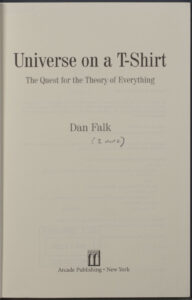The theory of everything – not to be confused with unified field theory, which is related but different – has been the Holy Grail of theoretical physics for centuries. The successful theory would explain all physical phenomena in the universe, making it possible, in theory, to predict the outcome of any experiment. “And while it will likely be expressed through abstract mathematics,” Dan Falk suggests, “the ideas at the heart of the theory may turn out to be extremely simple – so simple, in fact, that the essence of the theory can be written on a T-shirt.”
Falk’s popular account of the Theory of Everything, which won two awards after its original publication in Canada in 2002, explores both the theory’s history and its frontiers. Beginning with Thales and the science of ancient Greece, Falk traces relevant scientific progress through the Middle Ages, touches on Galileo and Newton, Einstein and Bohr, and brings us around to today’s theorists and the concept of string theory – the current frontrunner for the Theory of Everything.
“String theorists aren’t uncorking the champagne just yet, however,” Falk notes.
The biggest problem is that the theory describes how particles and forces behave at enormously high energies. Even the largest particle accelerators are about a billion billion times too weak to probe string effects by any direct experiment … To investigate strings directly, in fact, would require an accelerator roughly the size of the solar system.
While a viable theory seems out of reach for now, it should come as no surprise that members of MIT’s faculty have contributed to the pursuit of this scientific grail. And if someone here at the Institute were to articulate such a theory, making what might well be the greatest scientific discovery of all time, we certainly wouldn’t be opposed to uncorking that champagne.
If we’re lucky, it might happen next year, when Dan Falk will be a visiting Knight Fellow at MIT.



